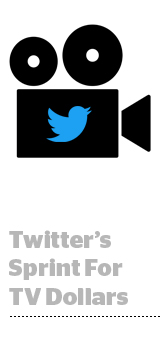
Twitter is gunning to become publishers’ platform partner of choice, and it’s leveraging live video as a way to capture content – and dollars – currently flowing to the duopoly.
This week, Bloomberg debuted its 24/7 global news network TicToc on Twitter after reaching nearly 8 million people during Bloomberg TV’s live stream of three presidential debates on the platform.
And BuzzFeed, which reaches about 1 million viewers through its live morning show, “AM To DM,” has renewed with Twitter for a second season come January.
“We realized where Twitter was best suited is its immediacy in delivering news as fast as possible,” said Bloomberg Media CRO Keith Grossman. “It beat out all other social platforms as it was related to speed.”
Despite Twitter’s bigger struggle to sort out its monetization story and grow its user base, Grossman said it has made massive strides in supporting live viewing experiences.
In the past year, Twitter has expanded its back-end infrastructure to accommodate more live programming. In Q3, Twitter streamed more than 830 events, 74% of which reached global audiences, and signed 30 new live-streaming video partners including both publishers and brands.
That capacity to support streaming for longer durations beyond short-form, user-generated clips via Periscope is enticing for video-centric publishers that want to tap into Twitter’s audience and increase live distribution.
 Bloomberg Reimagines Streaming Video
Bloomberg Reimagines Streaming Video
Bloomberg will use TicToc to surface news content from 50 dedicated editors, producers and social analysts who will create, curate and verify breaking news emerging in the Twittersphere.
Although Grossman acknowledged that the publisher has been picky about choosing platform partners, it sees Twitter as a strategic complement for news distribution.
“We’ve always ensured we get information to market as quickly and accurately as possible,” he said. “This is where the Twitter partnership made the most sense, not this idea of being everywhere.”
Bloomberg’s goal is to rethink the notion of what the streaming video experience should be.
“It’s not just talking heads the way TV is,” Grossman said. “It’s not trying to fill up empty space or air time the way TV can or has traditionally been structured.”
Grossman declined to share deal specifics or how revenue share will work with Twitter, though live video deals on Twitter typically include pre-roll for most partnerships. Each partnership varies depending on whether the publisher uses original programming or a simulcast.
Bloomberg has signed seven inaugural advertisers, each of which committed to a year of sponsorship work with TicToc. They will get an advanced integration to Bloomberg’s live video stream on Twitter, along with data and certain “exclusivity clauses” to ensure priority placement.
“We will also allow less technical integrations, more along the lines of work we’ve done with Twitter Amplify [where brands sponsor short clips and pre-rolls], but as it relates to the commercials and advertiser segments, these are bespoke integrations,” Grossman said.
BuzzFeed Builds A Twitter Base
Since BuzzFeed News launched the morning news show “AM to DM” on Twitter last September, it has produced 60 live shows and more than 70 hours of programming, said Cindy Vanegas-Gesuale, who was recently promoted to head of programming for BuzzFeed News from her prior role as executive producer of “AM to DM.”
“The idea was to produce a morning show for a Twitter power user taking into account who is the person going on Twitter and what do they look like,” she said.
 “We make a point to not only pause twice during the show to bring in the viewer’s comments and questions, but to ask them what they’d like us to cover from a news perspective.”
“We make a point to not only pause twice during the show to bring in the viewer’s comments and questions, but to ask them what they’d like us to cover from a news perspective.”
It’s paramount for any publisher testing Twitter live to retrofit their editorial and ad formats to fit the social feed, Vanegas-Gesuale said.
Before BuzzFeed went live with its Twitter morning show, its editors rigorously identified and took screenshots of graphics that did and didn’t work for the Twitterverse.
“You have to make smart decisions about graphics placements, how tight your shot is and the way you’re shooting because videos are sometimes the size of a thumbnail,” Vanegas-Gesuale said. “You can tell when people are plopping content from one platform to the next.”
Too many TV publishers also fell into the trap of taking linear cable content and simply repurposing it for social.
But that defeated the purpose of the bi-way broadcast and interaction between users, which Twitter has nailed.
“You very quickly realize you need to change the visuals, presentation or the topic line to be more in line with the way people were using those platforms,” Vanegas-Gesuale said. “We wanted to take ‘AM to DM’ to the next level and not resort to traditional production we see with regular morning shows.”
Twitter declined to speak on the record for this story.
This post was syndicated from Ad Exchanger.

More Stories
Around the World: AI & Christmas, a Temu crackdown and Aussie influencers
Here’s a Short Roundup for This Week
Melanie Spencer a finalist in Campaign’s Agency of the Year Awards